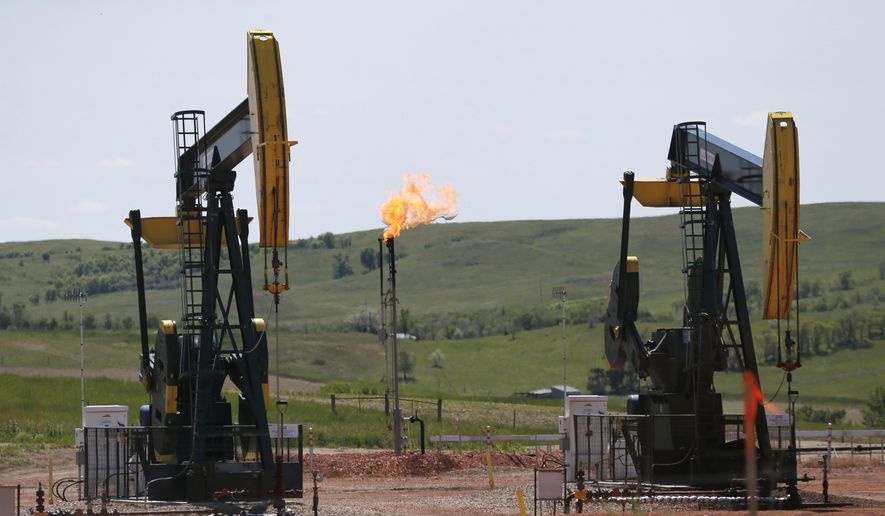The Obama administration rocked the energy sector Thursday by unveiling a finalized methane standard even tougher than the one proposed last year in the name of combating climate change.
The reduction standards on methane from new and modified oil and gas operations, aimed at reducing emissions by up to 45 percent by 2025 from 2012 levels, come at an estimated cost to the industry of $530 million per year, according to the Environmental Protection Agency.
That figure is about 25 percent higher than the preliminary figures released in August, which the EPA attributed to “new science and data have shown that methane emissions from existing oil and gas sources are substantially higher than was previously understood.”
“Today, we are underscoring the Administration’s commitment to finding commonsense ways to cut methane — a potent greenhouse gas fueling climate change — and other harmful pollution from the oil and gas sector,” said EPA Administrator Gina McCarthy in a statement.
But critics described the rule as an unscientific, punitive gesture intended to mollify the climate change movement even though the industry has shown significant progress in voluntarily reducing methane emissions.
“No industrial sector has done more to drastically reduce methane emissions through voluntary and other measures,” said Rep. Lamar Smith, chairman of the House Science, Space and Technology Committee.
“EPA continues to impose its ’command and control’ mentality to impose strict rules on industrial sectors it does not like, disregarding the great strides that industry has made to reduce emissions on its own,” Mr. Smith said. “The EPA has become a rogue agency trying to implement costly and unnecessary regulations.”
He described the methane rule as the latest regulatory hit to the private sector as President Obama nears the end of his second term, following the Waters of the United States, the Clean Power Plan and the Ozone National Ambient Air Quality Standards.
The cost of those rules has been estimated in the tens of billions of dollars. In the case of the methane rule, however, the EPA reported Thursday that the costs to society would be outweighed by factors such as improvements to public health and “climate benefits” such as fewer natural disasters driven by global warming.
“EPA estimates the final rule will yield climate benefits of $690 million in 2025, which will outweigh estimated costs of $530 million in 2025,” said the agency’s press release.
A 2014 EPA report found that the oil and gas industry had reduced methane emissions by 12 percent since 2011, “the largest reductions coming from hydraulically fractured natural gas wells, which have decreased by 73 percent during that period.”
Lee Fuller, executive vice president of the Independent Petroleum Association of America, said the rules would actually increase methane emissions by making it more expensive to produce natural gas.
“Even worse, EPA’s new rules will have virtually no impact on global temperatures,” Mr. Fuller said in a statement. “Instead, they will make it much more difficult for companies to continue producing the clean-burning fuel that has been responsible for making the United States the world leader in greenhouse gas reductions.”
Sen. Tom Carper, Delaware Democrat, acknowledged the industry has made “significant strides” in reducing methane emissions, but that further government regulation is needed to guard against a projected increase.
“Today’s common sense regulations from the EPA will help to ensure that we produce energy responsibly and that we reduce our carbon footprint,” said Mr. Carper, the top Democrat on the Senate Environment and Public Works Committee’s clean air subcommittee.
Anti-fracking groups praised the methane rule but also said it fell short of their goals, including a ban on hydraulic fracturing and fossil fuel production.
“To avoid the worst impacts of climate change, we must make deep cuts in all global warming pollutants, including methane. Today’s rule is a step forward, but it falls short of what’s needed to avert climate disaster,” said Rachel Richardson, director of Environment America’s Stop Drilling program.
She cited an EPA inventory released in April showing that methane emissions from 1990 to 2014 were 34 percent higher than previous agency estimates.
“In the near term, we need controls on existing fracking and drilling operations,” she said in a statement. “In the long term, we need to phase out our use of dirty fuels altogether and transition to 100 percent clean, renewable energy.”
A study released last year by the National institute of Water and Atmospheric Research published in the journal Science challenged the contention that fossil-fuel operations are driving rising methane levels, saying farming practices were the actual culprit.
• Valerie Richardson can be reached at vrichardson@washingtontimes.com.




Please read our comment policy before commenting.